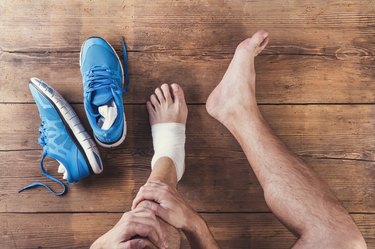
The road to a recovery after a foot surgery can be a tricky one. Pain and swelling are common side effects and each type of operation has its own unique challenges. With this in mind, however, focusing on regaining flexibility and strength typically results in the greatest chance of returning to your normal activities. After checking with your doctor to ensure it is appropriate after your particular surgery, try these home exercises to aid in your rehabilitation after a foot procedure.
Video of the Day
Video of the Day
1. Ankle Pump
Ankle Pumps are a great way initiate movement in the foot early on after surgery. This exercise also helps to push swelling from the foot by contracting your calf muscle.
HOW TO DO IT: Sit on your bed with your ankle hanging off the edge. Slowly move your foot up and down throughout its entire range. After 50 repetitions, take a break. Early on after surgery, try to do one set of pumps for each hour you are awake.
2. Towel Push
This exercise uses a towel to strengthen the muscles on the inside and outside of the foot, which are influential in maintaining your balance.
HOW TO DO IT: Sit in a chair with your foot resting on a towel. Without allowing your heel to leave the floor, use your foot to slide the towel in an inward direction. When you reach the end of the towel, reverse the exercise and move the towel outwards again. Perform three sets of 10 repetitions of the exercise in each direction.
3. Single leg Balance
This simple balance exercise helps your foot regain the stability it needs to negotiate uneven surfaces.
HOW TO DO IT: Stand at a counter or sink for support. Raise your good foot in the air as you attempt to balance on the affected leg. Hold this position for as long as you can before placing your other foot on the ground again. Begin by looking at your feet while you balance. When this is easy, progress the exercise by staring straight ahead or by closing your eyes. Attempt three sets of 10 repetitions each day.
4. Short Foot Exercise
This technique helps to activate the intrinsic muscles in the foot that help to stabilize your arch while you stand and walk.
HOW TO DO IT: Sit in a chair with your bare feet on the floor. Without curling your toes, draw your arch upwards by sliding your toes closer to your heel. Hold this position for 3 to 5 seconds before releasing it. Perform three sets of 10 repetitions daily.
5. Tandem Walk
Tandem walking is a great balance exercise that also helps you regain a normal gait pattern after a surgery.
HOW TO DO IT: Stand in a long hall way or an open room. While looking downwards, walk with a heel to toe pattern as though you are on a tightrope. Try not to lean your body or extend your arms to the side. As this becomes easier, progress the exercise by looking straight ahead. Do this daily in 3 to 5 minute increments.
6. Heel raise
This exercise focuses on strengthening your gastrocnemius, a bulky muscle in your calf that helps you push off while walking.
HOW TO DO IT: With your hands resting on a counter for balance, lift your heels off the ground as you rise up through your first and second toes. Hold this position for 1 to 2 seconds before lowering back down again. When three sets of 10 repetitions are easy, attempt the exercise using only your recovering leg.
7. Towel Stretch
This stretch helps you improve the flexibility in your calf and assists with regaining a normal heel to toe walking pattern.
HOW TO DO IT: Sit in bed with your leg outstretched in front of you. Wrap a towel around your foot and pull up towards you until a moderate stretch is felt in your calf. Hold this position for 30 seconds before releasing the tension. Do three to five repetitions of the exercise three times per day.
Warnings and Precautions
While each of the exercises listed above can be beneficial, it is extremely important to check with your doctor prior to beginning the regimen to ensure it is appropriate in your particular situation. Failure to do so may put your recovery from surgery at risk. In addition, any significant increases in swelling or pain should be reported to your physician as they may be a sign of something more significant like an infection or a blood clot.